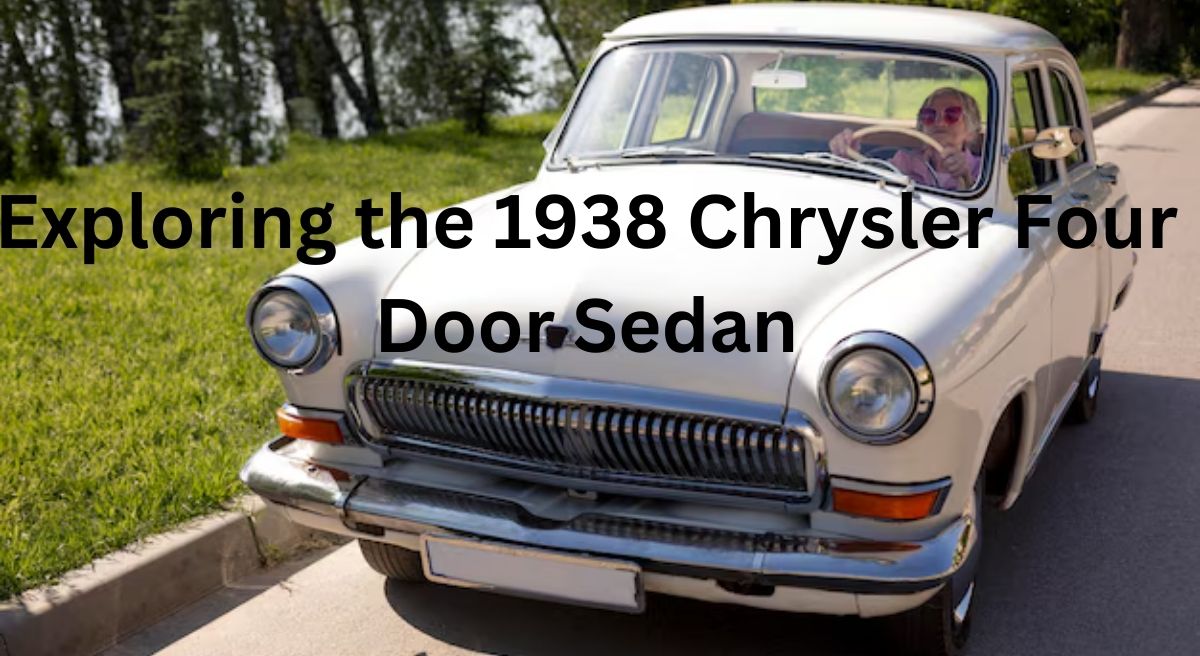TOPIC
A Classic Revival: Exploring the 1938 Chrysler Four Door Sedan

Introduction to the 1938 Chrysler Four Door Sedan
Step back in time to 1938, a year that marked the zenith of automotive craftsmanship with the release of the Chrysler Four Door Sedan. This elegant vehicle isn’t just another classic car; it’s a piece of history wrapped in chrome and steel. With its distinctive styling and advanced engineering for its time, this sedan captivated drivers and collectors alike.
Whether you’re an avid car enthusiast or simply appreciate timeless design, the allure of the 1938 Chrysler Four Door Sedan is undeniable. From family road trips to glamorous outings, this model has carved out a special place in hearts across generations. Let’s dive deeper into what makes this vintage automobile so remarkable and why it continues to resonate with collectors today.
The Design and Features of the Sedan
The 1938 Chrysler Four Door Sedan is a stunning example of automotive design from the late 1930s. Its streamlined silhouette exudes elegance and sophistication, capturing the essence of its era. The body curves gracefully, making it stand out on any street.
Attention to detail shines through in features like the distinctive grille and chrome accents. These elements not only enhance aesthetics but also reflect Chrysler’s commitment to quality craftsmanship.
Inside, spacious seating offers comfort for both driver and passengers. Luxurious upholstery choices add a touch of class that was ahead of its time.
Innovative engineering can be found under the hood too. Equipped with a powerful engine for smooth performance, this sedan combines style with practicality seamlessly. It’s no wonder collectors admire this classic as much today as they did back then.
Historical Significance and Popularity of the Model
The 1938 Chrysler Four Door Sedan holds a special place in automotive history. It emerged during an era of innovation, when manufacturers prioritized performance and style. This model epitomized the transition from classic designs to more streamlined aesthetics.
Its introduction coincided with rising consumer demand for family-oriented vehicles that combined comfort with sophistication. The sleek lines and elegant detailing captured the imagination of car enthusiasts across America.
This sedan was not just about looks; it also featured advanced engineering for its time, including fluid drive transmission options which enhanced driving smoothness.
As a result, the Chrysler Four Door Sedan quickly gained popularity among families and professionals alike. Its reputation for reliability coupled with luxurious touches made it a sought-after vehicle on roads across the nation in the late 1930s.
Maintenance and Restoration Tips for Collectors
Owning a 1938 Chrysler Four Door Sedan is a rewarding experience, but proper maintenance is key to preserving its charm. Regular checks on fluid levels—oil, transmission fluid, and coolant—can prevent costly repairs later.
Pay close attention to the electrical system. Vintage wiring can be prone to wear and tear. Upgrading old components with modern alternatives while retaining classic aesthetics can enhance reliability without sacrificing style.
Rust can be an enemy for classic cars. Inspect body panels and undercarriage regularly for signs of corrosion. Treat any small rust spots immediately with appropriate sealants or touch-up paint.
When restoring parts, aim for original specifications wherever possible. This maintains authenticity and value in the eyes of collectors.
Connecting with fellow enthusiasts through forums or local clubs can provide invaluable advice on sourcing rare parts or best practices in restoration techniques tailored specifically to this model.
Personal Testimonials from Owners
Owning a 1938 Chrysler Four Door Sedan is an experience unlike any other. Many owners share the thrill of cruising down scenic routes, with heads turning at every corner. One proud owner recalls how their sedan has become a family heirloom, bringing generations together for weekend drives.
Another enthusiast highlights the sense of community that comes with this classic vehicle. Local car shows and meetups are filled with stories about each model’s unique history. Each scratch and dent tells a tale worth sharing.
One driver notes the nostalgia that washes over them whenever they slide behind the wheel, feeling connected to an era gone by. Such sentiments resonate deeply among fellow collectors who appreciate not just the aesthetics but also what these cars represent—a slice of American automotive history waiting to be cherished anew.
Modern Adaptations and Modifications for Performance and Safety
Modern adaptations for the 1938 Chrysler Four Door Sedan are all about blending classic aesthetics with contemporary performance and safety features. Enthusiasts often explore engine upgrades, swapping the original flathead six-cylinder for a more powerful V8. This change significantly boosts horsepower while preserving that vintage charm.
Suspension modifications can enhance ride comfort and handling. Many owners opt for modern coilover systems to improve stability on today’s roads.
Safety is another priority. Upgrading brakes to disc systems can provide better stopping power, crucial in our faster-paced environment. Adding seat belts and modern lighting enhances both driver protection and visibility.
Some collectors even integrate technology like GPS navigation or Bluetooth sound systems into their vehicles, making road trips much more enjoyable without compromising style. Each modification opens up new possibilities while respecting the timeless essence of this classic sedan.
Conclusion: Why the 1938 Chrysler Four Door Sedan is Still a Timeless Classic
The 1938 Chrysler Four Door Sedan remains a cherished classic for many reasons. Its elegant design and exceptional craftsmanship have stood the test of time, making it a true symbol of automotive history. The combination of style, comfort, and practicality captured the hearts of car enthusiasts when it was first introduced.
As an icon from the late 1930s, this model represents a pivotal moment in American automotive manufacturing. It paved the way for future innovations while reflecting the era’s artistic sensibilities.
For collectors and restorers, maintaining or reviving this beauty offers both challenges and rewards. Engaging with fellow owners can enhance your appreciation for its historical significance as well as provide valuable insights into restoration techniques.
Many modern adaptations successfully breathe new life into these vintage vehicles without compromising their original charm. These modifications ensure safety and performance standards are met while still capturing that nostalgic essence.
The 1938 Chrysler Four Door Sedan embodies more than just transportation; it is a piece of living history. Whether you own one or simply admire them from afar, there’s no denying its lasting impact on car culture and enthusiasts alike. This timeless classic will always hold a special place within the ranks of iconic automobiles.
TOPIC
Where to Buy the YELL51X-OUZ4: A Comprehensive Guide

The YELL51X-OUZ4 is a highly sought-after model known for its advanced features and robust performance. Whether you’re a tech enthusiast or a professional looking for a reliable device, knowing where to purchase this model is crucial.
Official Website: The Safest Option
One of the best places to purchase the YELL51X-OUZ4 is directly from the manufacturer’s official website. Buying from the official site ensures that you receive an authentic product with the full manufacturer’s warranty and support. Additionally, the official website often offers exclusive deals, early access to new models, and bundled accessories that you might not find elsewhere.
- Benefits: Authentic product, comprehensive warranty, customer support, exclusive deals.
- Considerations: Prices may be higher than other options, and shipping times can vary.
Authorized Retailers: Trusted and Reliable
Purchasing from authorized retailers is another safe option. These retailers are vetted by the manufacturer, ensuring that the products they sell are genuine and come with the standard warranty. Authorized retailers include both physical stores and online platforms.
- Nationwide Chains: Stores like Best Buy and Walmart are authorized to sell the YELL51X-OUZ4. They often provide competitive pricing, in-store pickup options, and convenient return policies.
- Local Electronics Stores: Smaller, local electronics stores may also be authorized retailers. These stores offer the advantage of in-person shopping, allowing you to see the product before purchasing.
- Benefits: Access to authentic products, warranty, and after-sales support.
- Considerations: Limited availability depending on location, potential for higher prices compared to online marketplaces.
Online Marketplaces: Convenience and Variety
For those who prefer shopping online, online marketplaces like Amazon and eBay offer a wide range of options for purchasing the YELL51X-OUZ4. These platforms provide the convenience of shopping from home, along with customer reviews to help guide your decision.
- Amazon: Amazon is a popular choice due to its vast selection, customer reviews, and flexible shipping options. It also offers a robust return policy, making it a safe option for online shoppers.
- eBay: eBay can be a good source for both new and used YELL51X-OUZ4 models. However, it’s important to check seller ratings and product descriptions carefully to avoid counterfeit products.
- Benefits: Wide selection, customer reviews, competitive pricing.
- Considerations: Risk of counterfeit products, varying levels of customer service depending on the seller.
Second-Hand Options: Cost-Effective Alternatives
For those on a budget, purchasing a second-hand YELL51X-OUZ4 can be a viable option. Platforms like Craigslist and Facebook Marketplace allow for peer-to-peer transactions, where you might find used or refurbished models at lower prices.
- Certified Refurbished: Some retailers and online platforms offer certified refurbished YELL51X-OUZ4 models. These devices have been restored to like-new condition and come with a limited warranty.
- Peer-to-Peer Marketplaces: Buying directly from individuals can result in significant savings. However, it’s important to exercise caution, verify the product’s condition, and meet in safe, public locations.
- Benefits: Lower prices, potential for good deals.
- Considerations: Risk of buying defective or counterfeit products, limited warranty, and no return policy.
Price Comparisons: Getting the Best Deal
Before making a purchase, it’s wise to compare prices across different platforms. The YELL51X-OUZ4 typically ranges between $500 to $700, depending on the seller and the condition of the model.
- Seasonal Sales: Keep an eye out for discounts during holiday seasons or sales events like Black Friday. These sales can offer substantial savings, making it the best time to purchase.
- Discounts and Deals: Check online marketplaces for ongoing deals and discounts. Sometimes, retailers offer promotions that can significantly lower the price.
Warranty and Support: Ensuring Peace of Mind
When purchasing the YELL51X-OUZ4, it’s crucial to consider warranty and customer support. Ensuring your purchase comes with a warranty protects you against manufacturing defects and offers peace of mind.
- Understanding Warranties: Verify that your purchase includes a warranty that covers parts and labor. This is especially important if you’re buying from online marketplaces or second-hand sources.
- Customer Support: Opt for sellers known for excellent customer support. This is vital for resolving any issues that may arise post-purchase.
Conclusion: Making an Informed Purchase
In summary, of Where to Buy the YELL51X-OUZ4: A Comprehensive Guide the YELL51X-OUZ4 is available from a variety of sources, each with its own set of advantages and considerations. Whether you choose to buy directly from the official website, through authorized retailers, or online marketplaces, it’s essential to do your research, compare prices, and ensure you’re buying from a reputable source. By taking these steps, you’ll be able to enjoy the full benefits of the YELL51X-OUZ4 and make a purchase you can feel confident about.


